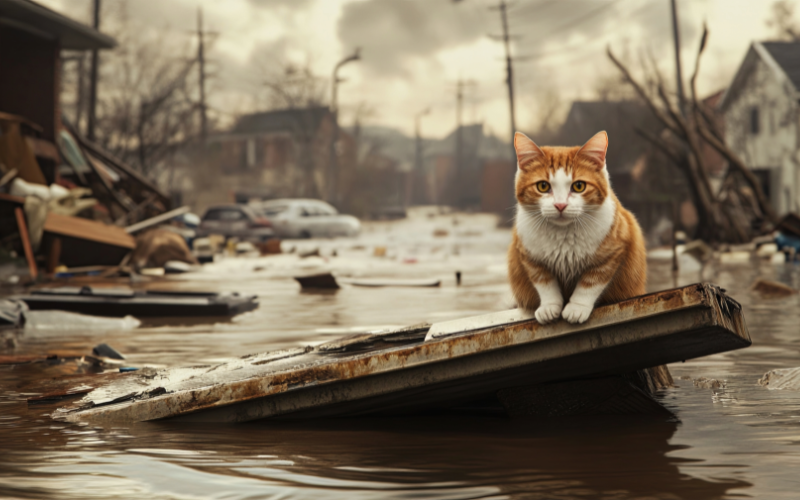Preparing for natural disasters is at the top of our minds. Recently, fires, tropical storms, hurricanes, and flooding have all made national headlines, and a new disaster is affecting one or more parts of the country almost every time we turn around. With fire season in full swing here in California once again, it’s crucial to remember that preparation and awareness are key in any emergency. However, it’s surprising that fewer than half of U.S. households have a disaster response plan, and even fewer have one that includes a plan for their pets.
In addition to our human family, we all must have a plan to care for our pets in the event of a prolonged power outage, wildfire, flood, or the need to evacuate quickly. September is National Disaster Preparedness Month, an excellent time to review best practices to ensure that you are prepared to care for your pets should a natural disaster strike. The team at AVSG IMUC has created this guide to help you care for your pets and make the best decisions for them in case of a natural disaster.
One step at a time
Disaster planning can become overwhelming if you try to tackle everything at once. When creating your disaster plan, take it one step at a time. It should include planning for a power outage, sheltering in place, handling an evacuation order, and creating a pet “Go Bag” with everything your pet would need if you had to evacuate or shelter in place for an extended period.
- Power outages — Due to heat waves, fires, and floods in our area, power outages are becoming more common. Since there is no predicting how long a power outage will last, ensure you have bottled water and a two-week supply of pet food, pet supplies, and any medications on hand at all times.
- Cell phone outages — Since cell phones may not work during a natural disaster, always keep a printed list of contact phone numbers with you. Include the phone numbers of your pet’s family veterinarian, the Animal Poison Control Hotline, AVSG IMUC (949-653-9300), and other emergency clinics.
- Evacuations — Always plan to take pets with you if you receive an evacuation order. You may be unable to return to your home promptly, if at all, and pets left behind aren’t safe. Emergency response teams prioritize human life over animals, so don’t rely on them to rescue your pets. In an evacuation, the safest place for your pets is with you.
If you are not at home during an evacuation, ask a trusted neighbor or friend for help evacuating your pets. Discuss this with them in advance before any crisis occurs. Make sure they have a key to your home (or where to find one), know your pets and their usual hiding spots, and can quickly find your pet’s “Go Bag.” [read further for details]
Resources for natural disasters with pets
Knowing where you can go with your pet is vital in an emergency.
Train your pet to travel — You can limit stress for your pets by teaching them to enter a crate or carrier and relax there willingly. Help them associate the crate with a positive experience. Be sure to have their blankets and toys inside to welcome them.
Create a list of housing options — In the event of a disaster, it’s important to be prepared with a plan for your pets. Many disaster shelters don’t allow pets, so it’s crucial to have a backup plan in place. Create a comprehensive list of friends, family members, pet-friendly hotels, campgrounds, veterinary clinics, and boarding facilities both nearby and farther away. If you anticipate the need to evacuate, it’s advisable to call ahead and make reservations for boarding and hotels, as pet accommodations fill up rapidly during emergencies.
Pack your pet’s “Go-Bag” — Create a pet evacuation kit and keep it in an easily accessible spot so you can grab it and go easily and quickly if necessary.
Know where to seek pet medical care — Most emergency clinics and IMUC will remain open during natural disasters such as wildfires. We will continue serving pets in need of emergency and life-saving care.
Create a pet evacuation “Go-Bag”
Having all your pet’s necessities gathered ahead of time in an organized location will make everyone’s life easier in any emergency. Choose a duffel bag or other large bin that’s easy to store and carry, and create your pet’s transportable “Go Bag:”
Their evacuation kit should contain:
- A backup collar and leash with tags
- Your pet’s carrier or crate
- A two-week supply of your pet’s medications, especially if they take long-term medication
- Pheromones or CBD, if recommended for a calming effect
- A two-week supply of food and water (remember to rotate perishables every two weeks)
- Canned food, pop-top cans, or a can opener and lids
- Food and water bowls; consider collapsible versions of both.
- A litter box, scoop, gloves, and a two-week supply of litter (if applicable)
- Spray cleaner, paper towels, and pet waste bags
- Your pet’s first aid kit
- Hand towels or unscented, gentle disposable baby wipes
- Toys, treats, your pet’s bed, and other comfort items
- Printed veterinary records and a current printed photo of your pet
- Printed lists of contact numbers and pet-friendly accommodations
Keeping your pet safe in a natural disaster
Pets can become stressed during any changes in their routine. An evacuation is stressful for everyone, so follow these tips to ensure you and your pet stay calm.
- Keep your pet’s microchip contact information current by checking the Universal Microchip
- Always keep your pet’s collar and tags or GPS tracker on them.
- Keep a current photo of your pet if you need to prove ownership.
- Give your pet lots of love, pets, and positive attention during stressful times.
- Ensure your pet is comfortable in their carrier or crate.
Being prepared for natural disasters, especially when it comes to taking care of pets, is essential. Being proactive can help save time, minimize stress, and conserve energy. If you have any concerns about how to prepare for natural disasters with pets, contact our team at 949-653-9300. Be sure to check the footer on our website for current hours.


